Do you wish you had a roadmap that showed you exactly what you need to do to achieve your nonprofit’s fundraising and development goals? An effective nonprofit fundraising plan can do just that. While many nonprofit fundraising plans simply sit on a shelf gathering dust, there IS a way to build a better plan you’ll actually use – one that maps your fundraising goals to your organization’s goals and strategic plans, defines tangible, achievable objectives and key results for each of your campaigns, helps you prioritize and make time for what matters, and most importantly, ensures that your fundraising drives the revenue your nonprofit needs to advance its mission.
We create dozens of plans that check all of those boxes every year in partnership with our clients. Now, we’re pulling back the curtain and showing you how we do it with our Essential Nonprofit Fundraising Plan Template. The template is one part example, so you can see what a successful nonprofit fundraising plan looks like, and one part workbook, so you can begin building your best fundraising plan ever and hitting your goals, even in the face of challenging times like these.
This post provides a look at what’s inside the Essential Nonprofit Fundraising Plan Template to help you determine if it’s the right place for your organization to start.
The Nonprofit Strategy SystemTM and Fundraising Planning
Like all of the strategies we develop at Prosper Strategies, we leverage our proprietary Nonprofit Strategy SystemTM, a practical, actionable method, for optimizing every aspect of your nonprofit and achieving peak organizational effectiveness. The system can be applied to every type of strategy your nonprofit builds, including a fundraising strategy.
The Nonprofit Strategy SystemTM includes the following three phases, which we we introduce you to through the pages of the Essential Nonprofit Fundraising Plan Template:
- People: engage your stakeholders and conduct research to shape your fundraising plan
- Strategy: develop a clear set of pillars and objectives for your nonprofit’s fundraising and communications function so you can focus on the right things at the right times
- Progress: put the systems and processes in place that will ensure you bring your fundraising plan to life, including key results, a measurement dashboard and more
People
The People phase of fundraising planning is designed to help you engage your nonprofit’s stakeholders in shaping your fundraising strategy.
Historically, there has been a disconnect between the way organizations communicate with their donors and the way they communicate with the individuals and communities they serve. Forward-thinking nonprofits are closing this divide by engaging those they serve in the strategy development process and through the adoption of diversity, equity and inclusion practices, including strength-based communication.
The first section on the Essential Nonprofit Fundraising Plan Template will teach you how to conduct stakeholder assessments to inform your fundraising plan, and provide guidance on how to conduct donor research. It will also help you determine what you are trying to learn from stakeholders, for example:
- What current perceptions do our stakeholders have about our fundraising?
- Were past campaigns representative of the work and communities we serve?
- Do our stakeholders feel they hear from us too much? Too little? Just enough?
Below is a snapshot of a page from the guide:
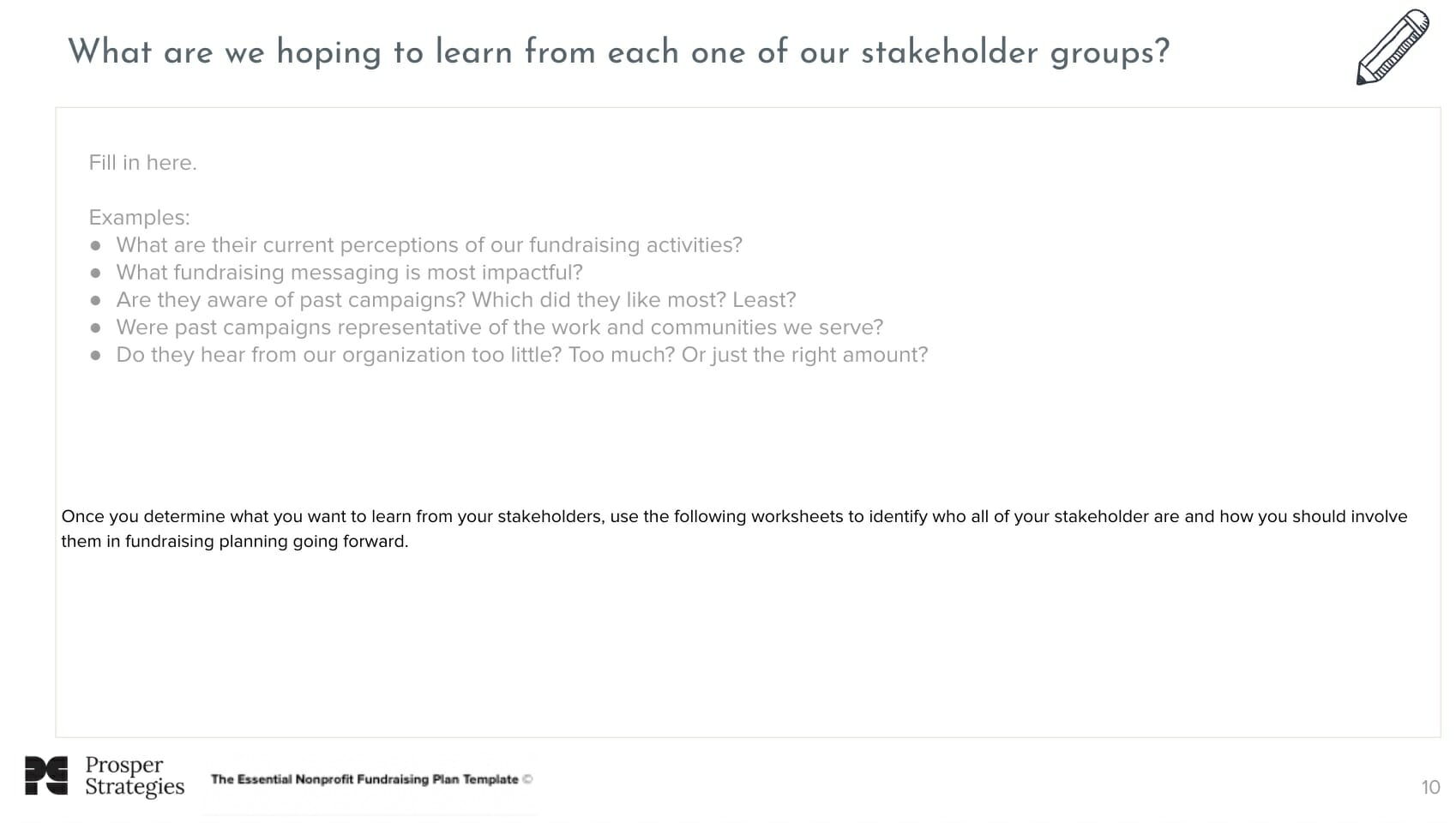
Engaging your organization’s stakeholders (including both the communities you serve and your donors) to build a more impactful fundraising strategy will not only help your nonprofit raise funds, but also drive your mission forward. Most importantly, continue to keep your stakeholders informed and involved as you shape your fundraising plan. Ask for their feedback again once you move into establishing pillars and objectives later in the process. The Fundraising Plan Template will show you how.
Learn more about stakeholder auditing and engagement.
Once you’ve sought initial input from your stakeholders, it’s time to conduct additional research that will inform your fundraising plan. Whether your nonprofit’s fundraising and development team is robust and sophisticated or small and nascent, you surely have access to fundraising data that will inform your plans moving forward. Gathering and reflecting on those data will get everyone involved in fundraising planning on the same page about where you’re starting from.
Research
This section of the Essential Nonprofit Fundraising Plan Template provides worksheets where you can fill in information about your donor activities and insights. We’ve made space for you to fill in information about the fundraising campaigns and activities your organization has engaged in over the last year and evaluate the performance of each one. We’ve also included space to audit each of the following elements:
- Donation page traffic
- Web traffic sources
- Most engaging emails
As you audit your existing approach to fundraising, keep the insights you gathered from your stakeholder assessment in mind. You might also want to dig in deeper to understand if donors reacted particularly strongly to specific stories or key messages, or if there were specific donor segments that really outperformed others. As you audit these areas, you’re aiming to get a better sense of what worked well and should be built upon, what worked poorly and should be discontinued, and what falls in the middle that might require more testing.
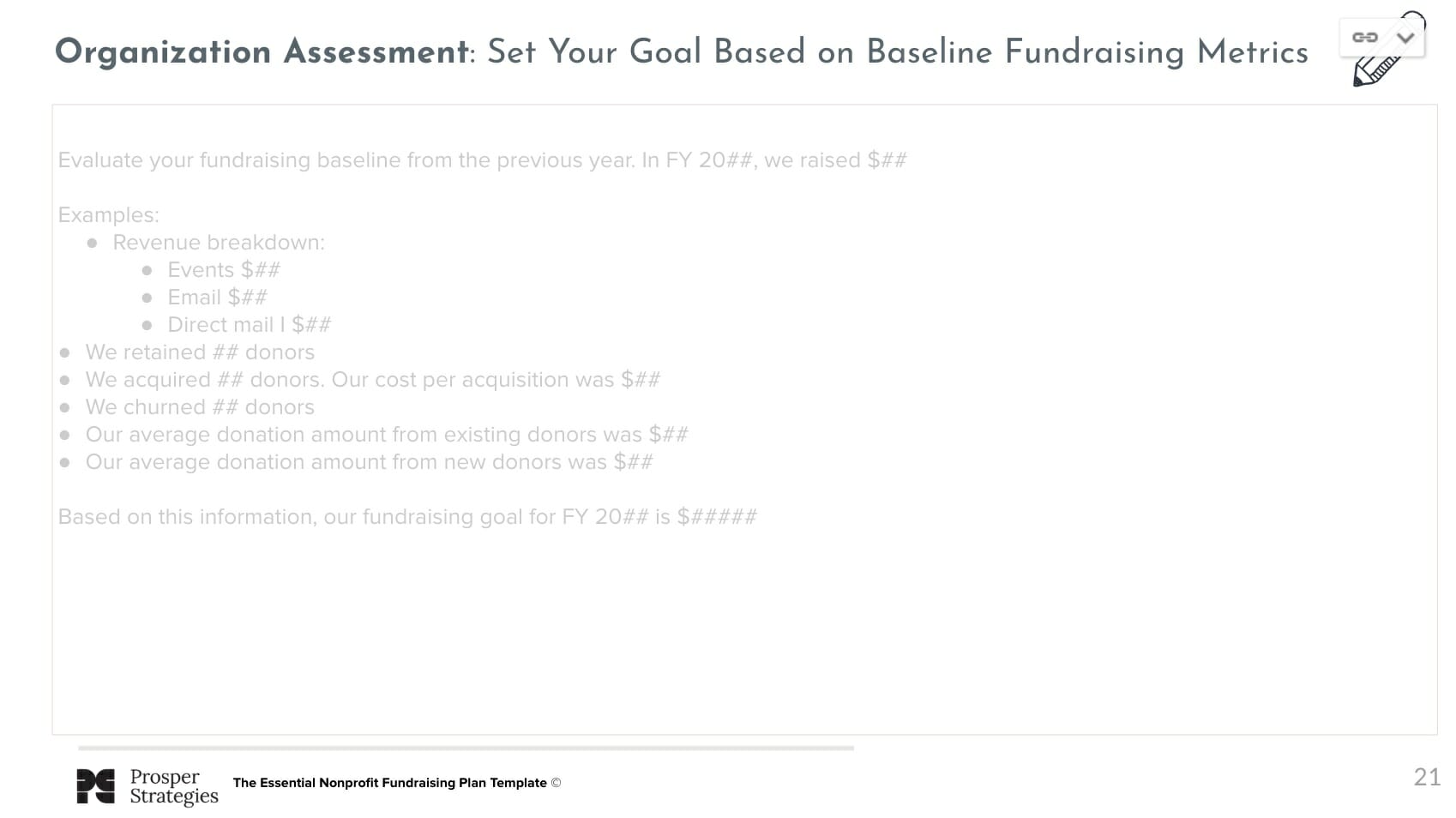
Additionally, the guide will help you conduct an ecosystem assessment to get a sense of how your organization’s approach to fundraising compares to other, similar organizations. While there are gaps in what you’ll be able to uncover about another organization’s fundraising strategy, it can be extremely helpful to review their external-facing material—like their website content, annual report and donation pages. This information ensures you have an understanding of how your organization is currently positioned relative to other nonprofits in your ecosystem.
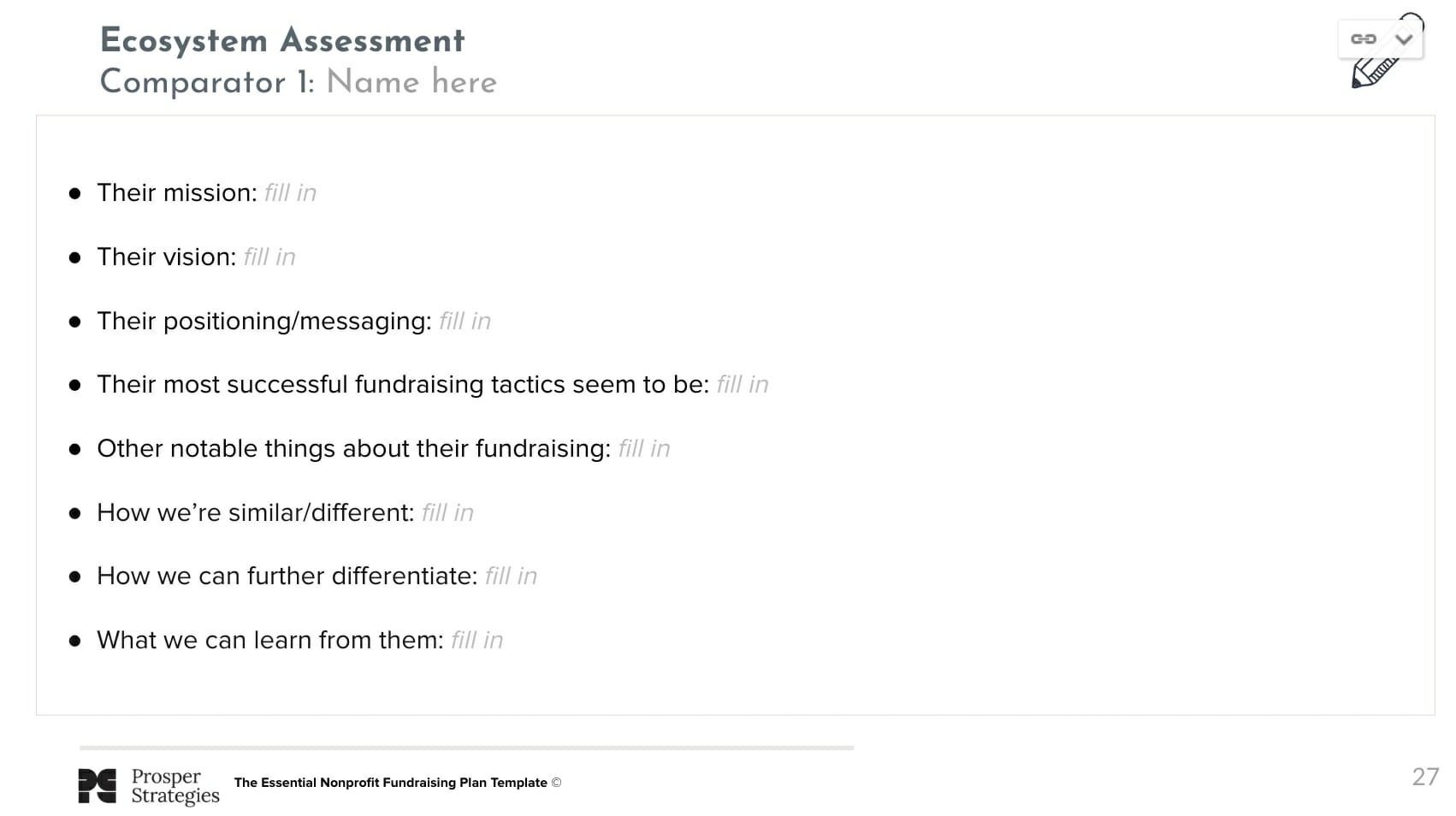
The combination of stakeholder inputs gathered in the beginning of the People phase of fundraising planning, along with these assessments, will begin to reveal strengths, weaknesses, opportunities and threats related to your nonprofit’s approach to fundraising, as well as other ideas you will likely want to address in the planning process. The Essential Nonprofit Fundraising Plan Template then helps you sum up your findings with a SWOT Analysis. Here, you can call upon all your key observations from the previous pages and then summarize your nonprofit’s fundraising strengths, weaknesses, opportunities and threats, on a high level, so you can determine the areas that most need your focus in your fundraising plan.
Learn more about auditing your fundraising efforts here.
Strategy
During the strategy phase of nonprofit fundraising planning, you will develop a clear set of pillars and objectives for your nonprofit’s fundraising and development function, so you can focus on the right things at the right times.
Pillars, Objectives and Key Results
With a thorough assessment of your own fundraising efforts to date, and understanding of your ecosystem and feedback from your stakeholders, you’re ready to develop the overarching goals, or guiding pillars, of your fundraising plan.
Through our work with hundreds of nonprofits, we’ve noticed a common mistake when it comes to setting fundraising goals: most organizations do not begin with their strategic plan and mission in mind and then set aligned fundraising goals that will drive both forward. As a result, they end up with goals that sound good on paper, but do not make strategic and thoughtful use of the organization’s time, budget and brainpower.
That’s why we prefer to use a set of tools called pillars, objectives and key results instead of traditional goal setting. Pillars, objectives and key results virtually ensure your organization will be focused on the right things at the right times in order to position fundraising to move your mission forward.
The next section of the Essential Nonprofit Fundraising Plan Template helps you come up with a long list of potential pillars – or areas of focus for your fundraising plan – that align with your strategic plan. Then, helps you prioritize between those potential pillars based on the lift they will require and the impact they will make. You’re aiming to end up with 3-4 fundraising pillars.
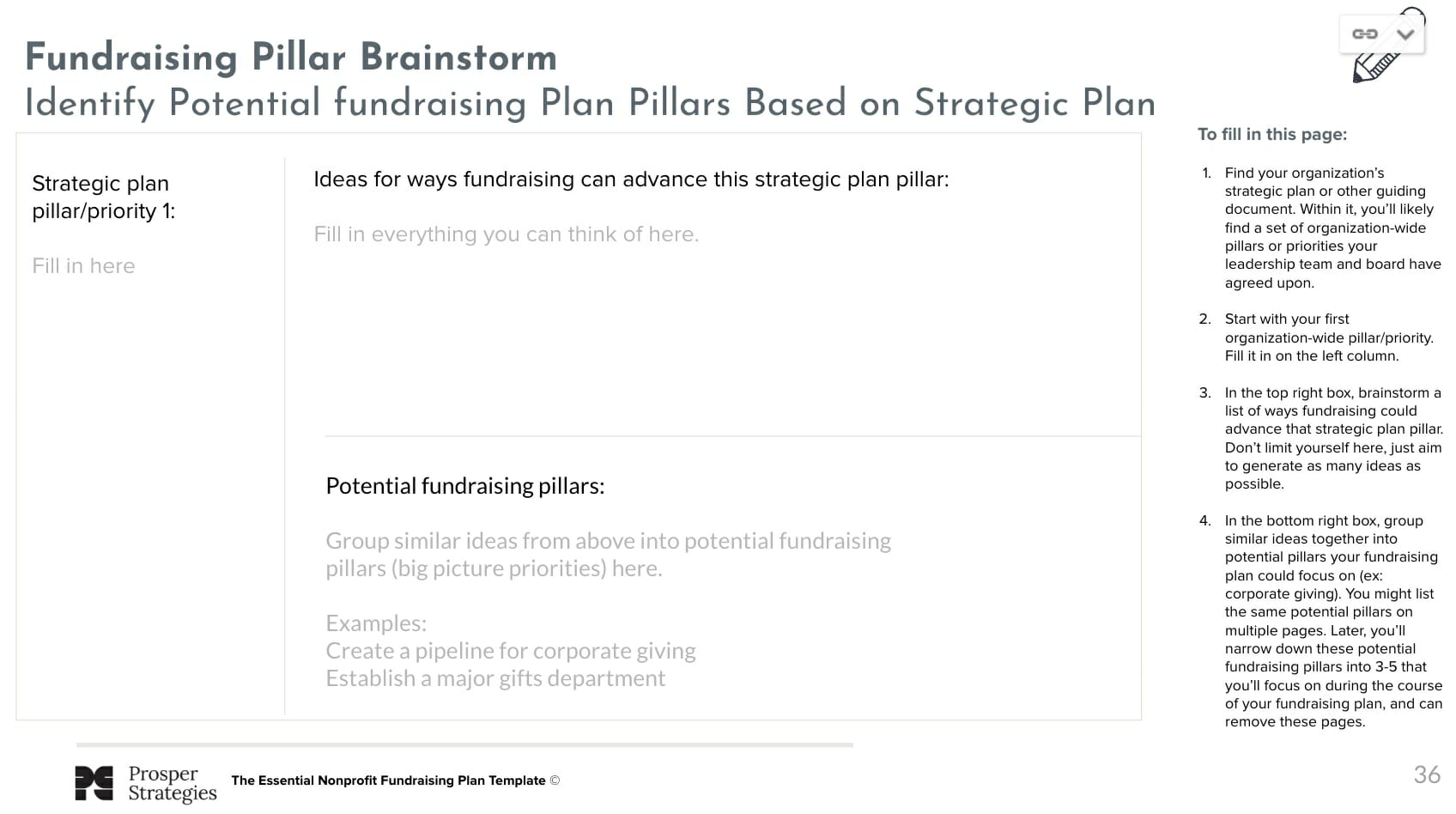
For each of your fundraising plan pillars, you will then create a set of 1 to 4 objectives, which are the measurable outcomes you need to achieve to make it a reality. Keep in mind that effective objectives are:
- Ambitious: objectives should represent a significant change or leap forward, not something that would be likely to happen through continuing “business as usual.”
- Memorable: objectives should be concise and easy to remember, recite and reflect on while you’re going about your day-to-day work.
- Mission-aligned: objectives should play a clear role in advancing your organization’s mission via fundraising.
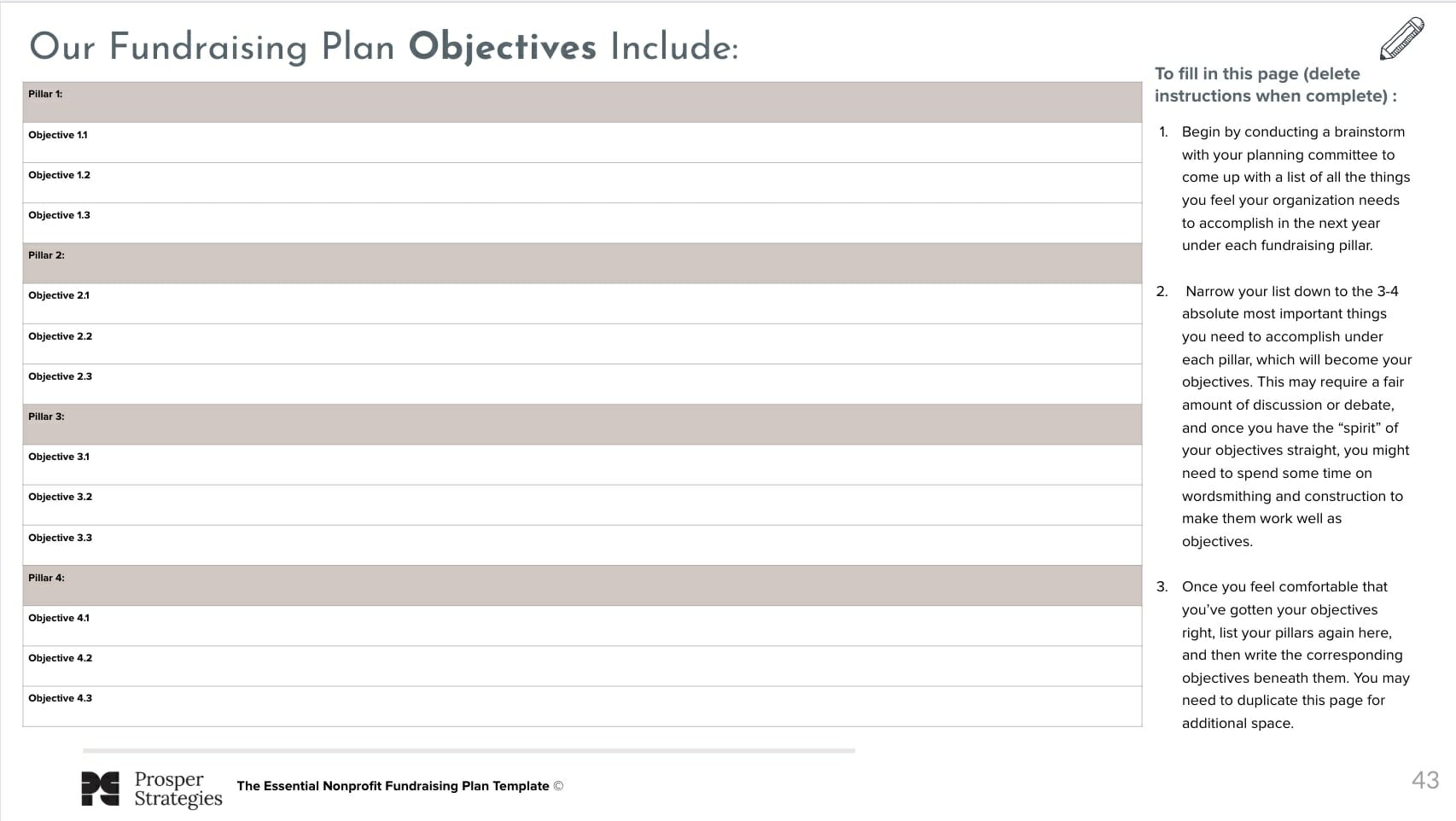
While pillars and objectives will get you focused on the most important new initiatives your department needs to prioritize, there is a whole lot more that just needs to happen in the course of maintaining an active, effective nonprofit fundraising department. Things like maintaining a relationship with donors, working towards corporate giving plans, working with the marcomm to send out emails with a call to donate, etc. We call all of that other stuff your “keep the lights on” activities. While these activities aren’t typically as high-priority as your pillars and objectives, you should still account for them in your fundraising plan. Doing so will help prevent things from falling through the cracks. It will also allow you to properly evaluate and distribute your team’s resources so that pillars and objectives don’t constantly get deprioritized in favor of day-to-day “keep the lights on” activities. The Essential Nonprofit Fundraising Plan Template helps you get a handle on all of your “keep the lights on” activities and even provides a calendar you can use alongside your pillars and objectives so that you can distribute your team’s resources appropriately.
Keep in mind: Marketing and fundraising goals are not one and the same. Learn more about setting nonprofit fundraising goals and learn more about setting pillars, objectives and key results.
Tactical Selection
While most people want to start with tactical selection, it is absolutely essential to do the work detailed in the previous parts of the Essential Nonprofit Fundraising Plan Template before diving in here. Once you know what you’re trying to achieve to move your strategic plan forward via fundraising (your pillars and objectives) and what else you need to tackle to keep your organization’s fundraising function running smoothly (your “keep the lights on” activities) you can choose the vehicles to make it all happen: your tactics.
The template provides an overview of commonly used nonprofit fundraising tactics, and then helps you brainstorm which are best to help you reach your nonprofit’s goals.
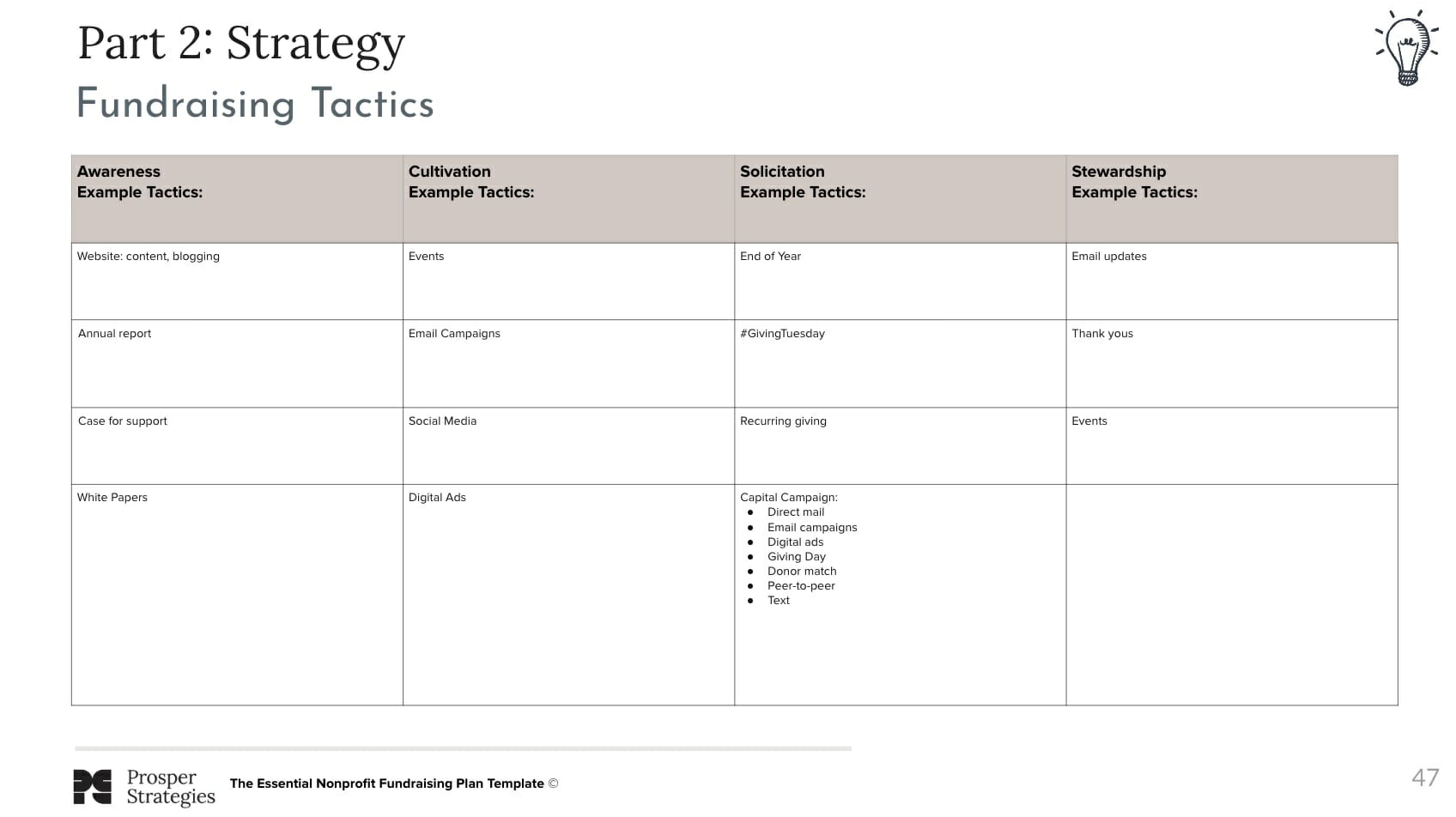
Progress
The Progress phase of nonprofit fundraising planning is designed to help you develop key results that will allow you to measure and optimize your fundraising progress and maintain accountability.
Key results are where the real power of your fundraising plan will lie, because they break your objectives down into actionable milestones or measures that when hit, virtually ensure positive forward momentum. This section of The Essential Nonprofit Fundraising Plan Template guides you in setting key results that include a mix of output and outcome-oriented key results.
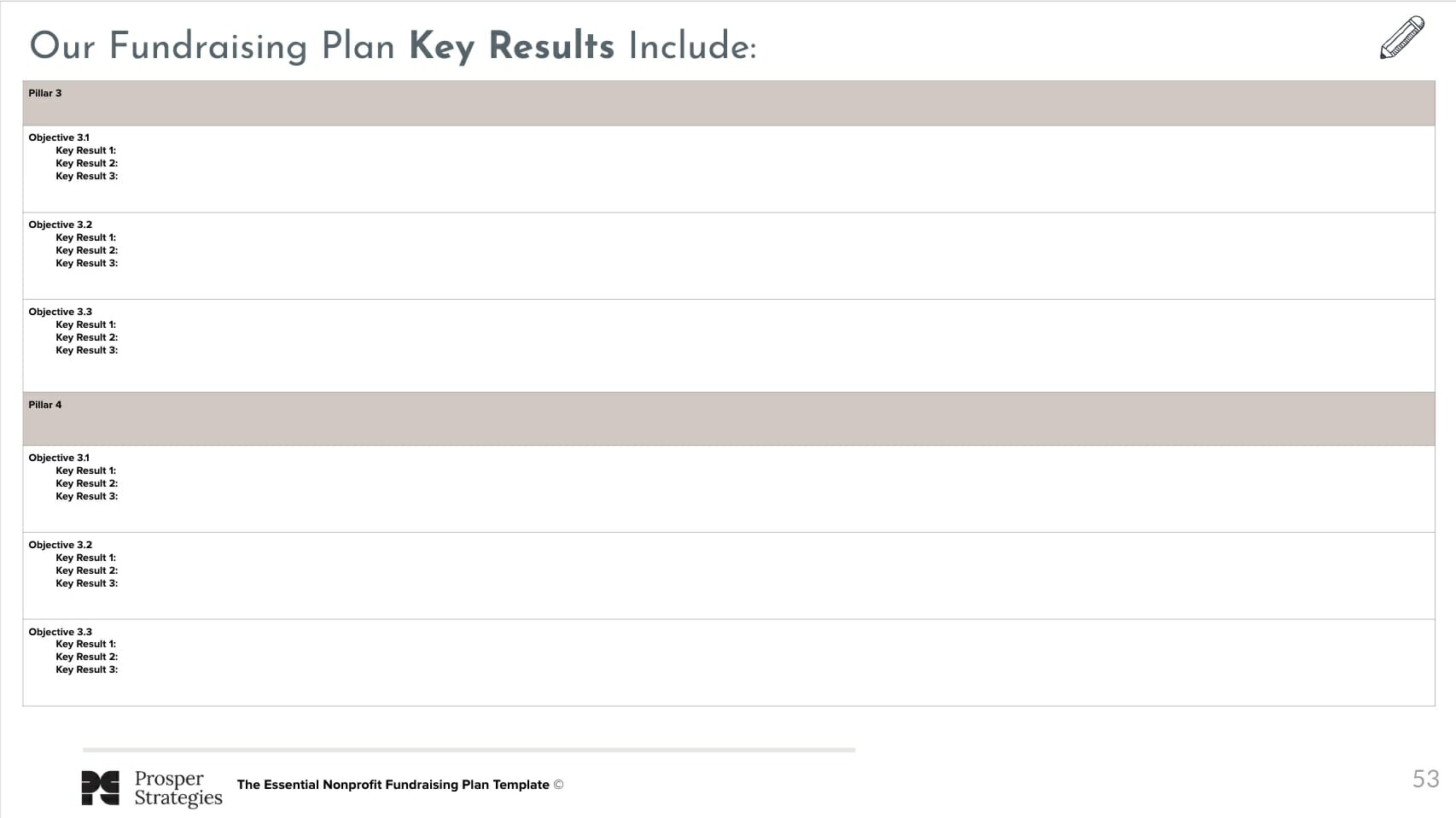
The last part of the Essential Nonprofit Fundraising Plan Template guides you in establishing a regular meeting cadence to discuss progress, identify roadblocks and make adjustments as needed.
Remember, your nonprofit fundraising plan should be a living, breathing document.
As your organization changes, it’s only natural for your fundraising goals and plans to change with it.
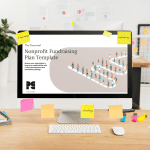
Ready to get started? Find more guidance, along with more examples and tools you can use to build your plan, by downloading the Essential Nonprofit Fundraising Plan Template. And if you need more help with fundraising and development efforts reach out.
Also check out these related resources:
End of Year Fundraising Checklist
How to Leverage Storytelling for Fundraising Success
How to Develop a Campaign Concept for Your Nonprofit Fundraising or Communications Campaign
How Your Fundraising Team Can (and Should) Work with an Agency